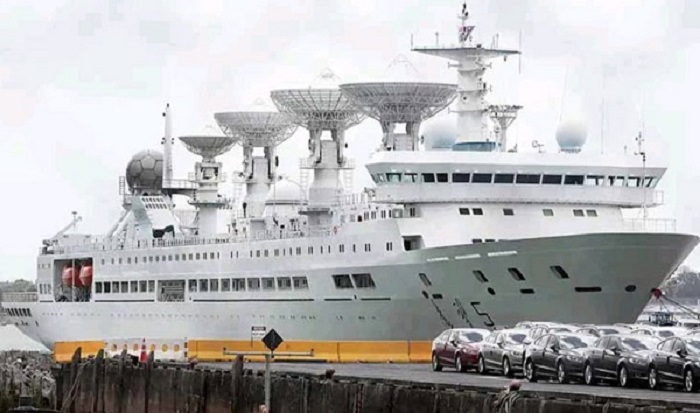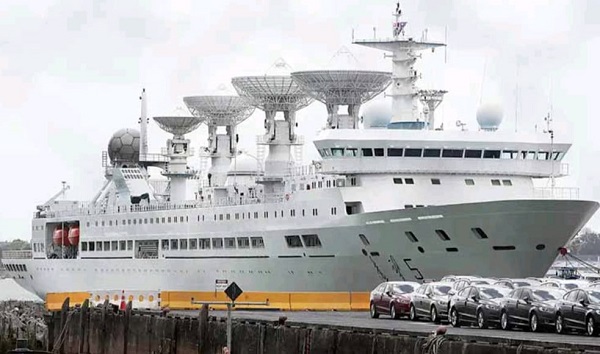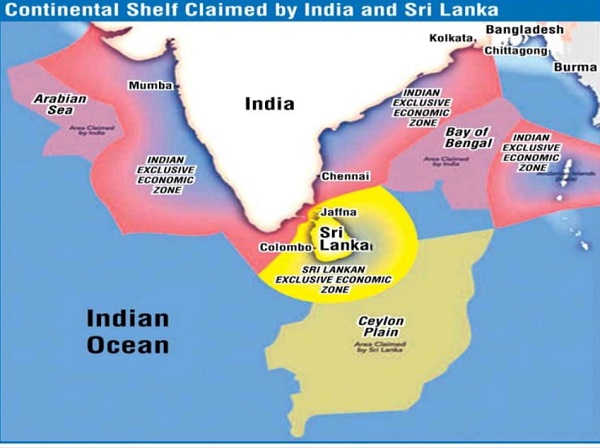
By Admiral Ravindra C Wijegunaratne
A Chinese spy ship docking at the Hambantota Port has become news in Sri Lanka and India. Yet very few seem to be asking as to what exactly a spy ship is. Simply put, it is a ship dedicated for reconnaissance missions, especially electronic eavesdropping.
A considerable number of countries use ships for snooping into both enemy and friendly countries via electronic intelligence. A former Indian Chief of Naval Staff more or less put it in perspective when he stated recently that naval espionage is “happening every day”, a fact which, according to him at least, “[n]o one deny.”
Spy ships are deployed the world over. Here is a tentatively comprehensive list from Wikipedia.
- Chinese Navy:
- Type 813 spy ship
- Type 814A spy ship
- Type 815 spy ship
- Yuan Wang-class tracking ship
- Finnish Navy
- Kustaanmiekka (Decommissioned)
- French Navy
- Dupuy de Lôme
- German Navy
- Oste-class fleet service ship
- Indian Navy
- INS Avnesh
- INS Dhruv
- Italian Navy
- Elettra
- Royal Norwegian Navy
- Marjata (1992)
- Marjata (2014)
- Polish Navy
- ORP Nawigator
- ORP Hydrograf
- Russian Navy
- Primor’ye-class surveillance ship
- Balzam-class intelligence ship
- Vishnya-class intelligence ship
- Yantar
- Spanish Navy
- Alerta
- Swedish Navy
- HSwMS Orion
- HSwMS Carlskrona
- United States Navy:
- USS Oxford
- USS Georgetown
- USS Jamestown
- USS Belmont
- USS Liberty
- USS Banner
- USS Pueblo
- USS Palm Beach
- USNS Private Jose F. Valdez
- USNS LT. James E. Robinson
- USNS Sgt. Joseph E. Muller
- USS Sphinx
Obviously, the list is long. These ships sail in international waters, taking care not to enter the territorial waters of any country and at the same time do their job for their country.
For instance, during the Cold War, Russian fishing trawlers with electronic monitoring equipment trailed US Navy Aircraft Carrier groups.
The Cold War may have ended, but the use of such ships continues.
Do you remember four Chinese scientists, seniors from South China Sea Institute of Oceanography (SCSIO), who lodged at the Kingsbury Hotel around the time of the Easter bombings in 2019? They were preparing to join a research vessel in a few days at the Colombo Harbor. Did any intelligence unit trail them?
Deep sea mining is big business in the Indian Ocean. Very few countries have the technology and the expertise to carry out such oeprations. China is one of them. It is no secret, then, that India is closely monitoring the Chinese navy. The old cat and mouse game is still on.
China is an important partner in the development of Sri Lanka. They helped us at all international forums, especially at the UN Human Rights Commission. As Sri Lankans we should not forget that China is a permanent representative in UN Security Council, with veto powers.
The Chinese ship at the heart of the recent controversy asked permission to enter the Hambantota harbor for the replacement of victuals after 28 days at sea. The crew also needed to get rest, to get involved in recreational activities. The foreign currency this would have brought into the country would have been lost, had the ship been denied entry. Sri Lanka, in other words, would have lost a noticeably big opportunity.

Chinese Satellite Tracking Ship
Supplying fuel, fresh water and victuals to warships with a large crew is a very lucrative business. Singapore replenishes US ships in the region and earns lucrative foreign exchange. Sri Lanka has what it takes to transform into a supply hub for warships, be they Chinese, US, Indian, Russian, Japanese, or any other nationality.
Warships possess the “right of innocent passage” as per the UN Convention for the Law of the Sea (UNCLOS). If these ships are following an innocent passage, they can enter the ports of friendly countries. In that sense, the Chinese ship has the right to enter Hambantota.
From an objective perspective, the Indian pressure on Sri Lanka not to allow the Chinese ship to enter Hambantota harbor seems uncalled for. Due to these pressures, the ship stopped on its way to the Hambantota port and stopped carrying out underwater surveys of the mountain range beneath the Indian Ocean.

What are these researchers looking for? New precious metal nodules? What are the exact parameters of the area in which they are operating? We should work hard to answer these questions.
Meanwhile, our Foreign Office has a very delicate task ahead in balancing India and China. As long as we remain non-aligned, we have nothing to fear.
Some years ago, during the Sirisena presidency, a large number of foreign warships entered our ports, mainly to Colombo. At times three ships from three different countries were berthed in three different locations at the harbor. No questions were raised by these countries, thanks to the Navy alerting their respective Defense Attaches and Advisers with the help of our Foreign Office. Such a system can go a long way in reducing misunderstandings.
Retired from the Sri Lanka Navy, Admiral Ravindra C Wijegunaratne served as the Chief of Defence Staff from 2017 to 2019.
Factum is an Asia-focused think tank on International Relations, Tech Cooperation and Strategic Communications based in Sri Lanka accessible via www.factum.lk
